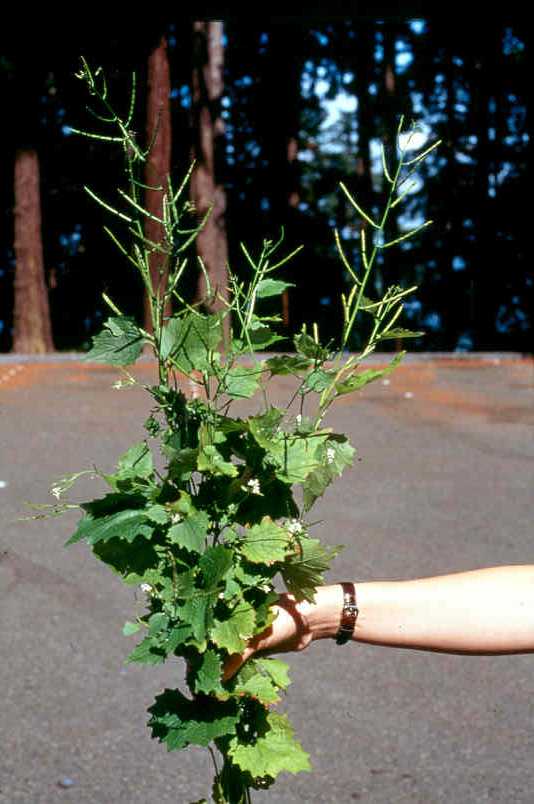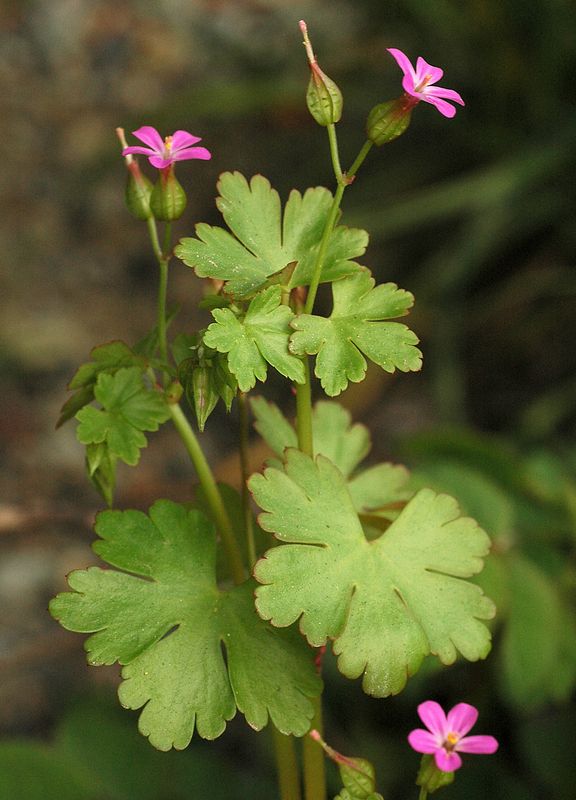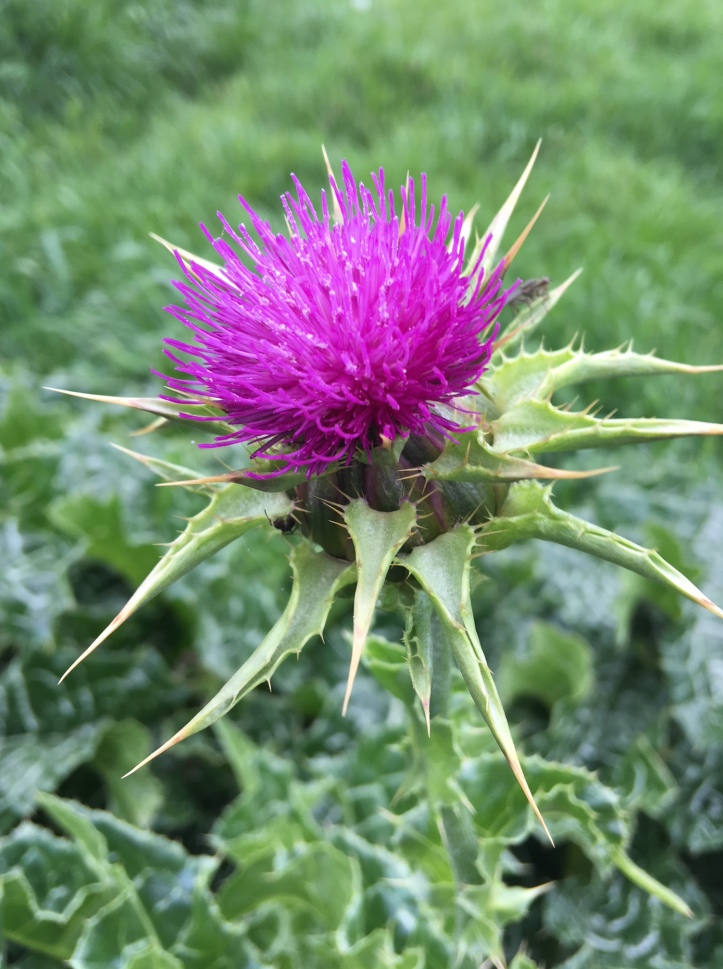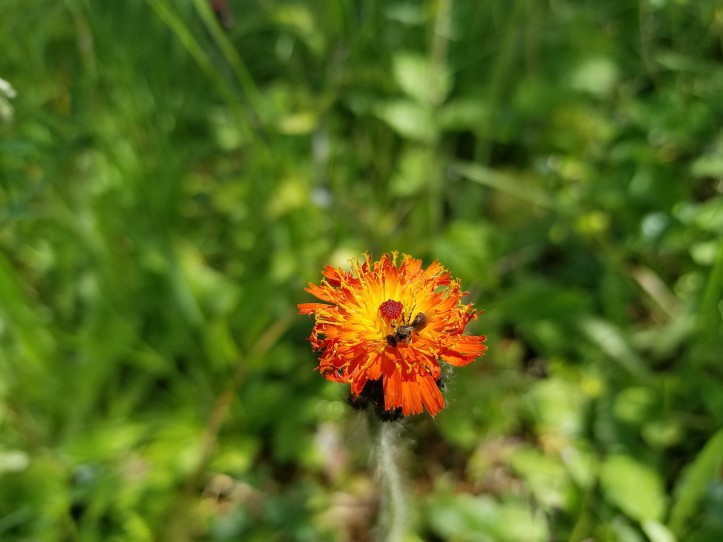If you’ve made it outside on a recent sunny day, you’ve probably noticed the abundance of flowers blooming in gardens, parks, forests, and throughout King County right now. Unfortunately, the noxious weeds are out there, too—many of them bolting, flowering, and even going to seed already.
Below are some of the top regulated noxious weeds to keep an eye out for this month. Please let us know if you see one of these high-priority invasive plants, so we can make sure they’re controlled or eradicated in time! [Click here to go to the King County Noxious Weed List for the whole list!] Report locations and share photos with us easily on our new and improved Report a Weed online form.
1. Top priority: eradicate before seeds disperse
First up, weeds already going to seed or getting close. Catch them now before seeds disperse!

Garlic mustard (Alliaria petiolata), a Class A noxious weed, is a biennial or winter annual herb, can self-pollinate to produce 62,000 seeds and overtake a relatively undisturbed forest understory. Eradicating it before seeds mature is key. You can identify garlic mustard by:
- Scallop-edged, rounded leaves (on rosettes) or toothed triangular leaves (higher up on mature plants) that feel smooth (hairless) and smell like garlic smell when crushed
- Small, 4-petaled white flowers and long, skinny seedpods
- Root bent in a distinct “s” shape
- Highly variable form, maturing and setting seed at anywhere from a few inches to 6 feet tall

Shiny geranium (Geranium lucidum), a Class B noxious weed, is an annual herb that grows in disturbed areas such as roadsides, as well as in shady woodlands and forest openings. This weed is already starting to form seed capsules, though it isn’t dispersing seeds yet. You can identify it by:
- Reddish, smooth stems that can reach 20 inches tall
- Shiny, round to kidney-shaped leaves with 5-7 lobes, usually shiny (not fuzzy)
- Leaves often turn red in sun or as plants are going to seed
- Tiny pink-purple 5-petaled flowers that appear in pairs at stem ends
- Keeled sepals
- Seeds in long capsules that look like cranes’ bills
- Does not smell bad like herb Robert and is not covered with soft hairs like Dove’s foot geranium
2. In full flower
The next group of weeds are now in full flower and before long will go to seed. Make sure you eradicate them from your property before they do.

Milk thistle (Silybum marianum) is a Class A noxious weed that grows 2 to 6 feet tall and is a winter annual or biennial that grows mostly in rural parts of King County. You can identify it by:
- Shiny green leaves with distinct milky-white marbling
- Spines on leaf edges and stems
- Large, pink-purple flower heads appearing singly at stem ends
- Broad, fleshy, spiny bracts around base of flower head

Orange hawkweed (Hieracium aurantiacum) and yellow hawkweed (Hieracium caespitosum) are two Class B perennial herbs that readily invade roadsides, pastures, grasslands, and other areas throughout King County. Both weeds spread via seeds and stolons. You can identify them by:
- Hairy, unlobed leaves in rosettes at the base of hairy, almost leafless stem
- Black, ball-shaped, tightly-clustered flower buds followed by orange (H. aurantiacum) or yellow (H. caespitosum) blooms (look like little dandelion flowers)
- Milky juice inside all plant parts
- Fluffy, dandelion-like seed heads
- Fuzzy white stolons (runners)

Dalmatian toadflax (Linaria dalmatica ssp. dalmatica), a Class B noxious weed, is a perennial plant that grows to 3 feet tall and mostly grows in disturbed areas in western Washington. It spreads by both seed and spreading roots. You can distinguish it by:
- Multiple stems that grow from one woody base
- Bluish green, heart-shaped, waxy leaves that wrap around each stem
- Bright yellow, snapdragon-like flowers growing in rows at stem ends

Sulfur cinquefoil (Potentilla recta) is another Class B noxious weed and perennial herb that reaches 3 feet tall. You can distinguish it by:
- Palmately lobed leaves with 5-7, long, toothed leaflets
- Upright, hairy, leafy, mostly unbranched stems (hairs stick straight out from stems unlike on the similar native species graceful cinquefoil, Potentilla gracilis)
- Pale yellow flowers with 5 heart-shaped petals and darker yellow centers
3. Budding or starting to flower
At a bit earlier stage in their life cycles, the following plants are either budding or just starting to bloom.

Tansy ragwort (Senecio jacobaea), a Class B noxious weed, is a biennial found throughout King County that is toxic to horses, cattle and other animals. It quickly takes over disturbed areas, thriving in sites with full sun and dry to somewhat wet soils. You can identify it by:
- Ragged, ruffled leaves that are dark green on top and light-green below, with deeply cut, blunt-toothed lobes
- First year plants are basal rosettes; second year plants have 2 to 4-foot-tall flowering stalks
- Clusters of numerous small daisy-like flowers with 13 yellow ray petals and yellow-orange centers

Giant hogweed (Heracleum mantegazzianum), a Class A noxious weeds, is a perennial that usually grows in urban areas, especially where there’s rich, damp soil. This plant is poisonous, and touching its sap can cause severe blisters or even scars, so it’s good to know how to recognize it. You can identify it by:
- 8-15-foot-tall, hollow, ridged stems with reddish-purple blotches and stiff white hairs
- 3-5-foot-wide, deeply incised, compound leaves
- Surface of leaf underside is hairless, with hairs only on ribs
- 2-foot-wide umbrella-shaped flower clusters

Spotted knapweed (Centaurea stoebe), a Class B noxious weed, is a biennial or short-lived perennial that often appears in disturbed areas, especially those with full sun and well-drained soils. You can identify it by:
- 5-foot-tall, upright, branched stems
- Medium-green, somewhat silver-gray, often deeply lobed leaves
- Small, oval flower heads with light purple to pinkish, thistle-like flowers
- Bracts at base of flower head have triangular black spots
- Stout taproot

Meadow knapweed (Centaurea jacea x nigra), another Class B noxious weed related to spotted knapweed, is loner-lived perennial that grows in not only disturbed sites, but also riverbanks, pastures, moist meadows, forest openings, and other areas. You can identify it by:
- 4-foot-tall, upright, branched stems
- 4-inch-long, slender, often shallowly lobed basal leaves and smaller, unlobed stem leaves, all coarse and tough
- Single oval flower heads with pink to reddish-purple flowers at branch ends
- Bracts at base of flower head have comb-like fringe near tip
4. Plants to keep an eye on
Plants in this final group are putting their energies into growing right now. They won’t go to seed until later this summer, but keep a tab on them and make sure you’re ready to control them when the time comes.

Policeman’s helmet (Impatiens glandulifera), Class B noxious weed, is a 3 to 8-foot-tall annual that grows especially well in moist areas, such as wetlands, streams, and damp woodlands. You can identify it by:
- Upright, hollow, watery, purple-reddish tinged stems
- Large, oblong or egg-shaped leaves with serrated edges, growing opposite or whorled in groups of 3
- White to pink to purple 5-part flowers that resemble an English policeman’s helmet
- Stem base and exposed roots often reddish

Purple loosestrife (Lythrum salicaria), Class B noxious weed, is a deep-rooted, rhizomatous perennial found mostly in damp areas, such as freshwater and brackish wetlands, as well as lakes and streams. It spreads through both vegetative growth and seeds. You can identify it by:
- Stiff, 4-6-sided stems that reach 6-10 feet tall
- Simple, smooth-edged leaves that grow opposite or whorled on stems
- Tall spikes of small magenta flowers with 5-7 petals
- Woody taproot

Garden loosestrife (Lysimachia vulgaris) is another Class B noxious weed and deep-rooted perennial often found in wet areas, although it’s not related to purple loosestrife (despite the common names). Garden loosestrife spreads primarily via creeping rhizomes. You can identify it by:
- 3-6-foot-tall, softly hairy stems and leaves
- Lance- or egg-shaped leaves, growing usually in whorls of 3
- Bright yellow flowers with 5 petals joined at their bases, appearing in clusters near tops of plants
For more information about how to identify and control these noxious weeds, follow the links above or visit our website. Feel free to contact us with any questions, too, by calling 206-477-WEED (206-477-9333) or emailing noxious.weeds@kingcounty.gov.







































